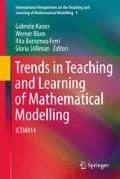Abstract
As a result of the standard-based curricula, in several countries secondary teachers’ beliefs about applications or modelling have developed in the scope of mathematics education. In contrast, German secondary teachers rarely integrate applications or modelling into their instructional practice. This research report is focused on teachers’ beliefs that hinder or promote integrating applications or modelling into their teaching practice. The objective of this approach was to reconstruct the teachers’ belief systems concerning applications. The undefined term “beliefs” is specified by the psychological construct of “subjective theories.” In this chapter, results with reference to the subjective theories of teachers with respect to modelling will be presented. Furthermore, some recommendations concerning teacher training will be sketched.
Access this chapter
Tax calculation will be finalised at checkout
Purchases are for personal use only
References
BIQUA (2007). Die Bildungsqualität von Schule. Abschlussbericht. http://www.ipn.uni-kiel.de/projekte/biqua/index.html Accessed 10 September 2010.
Calderhead, J. (1996). Teachers: Beliefs and knowledge. In D. C. Berliner (Ed.), Handbook of education (pp. 709–725). New York: Macmillan.
Chapman, O. (2001). Understanding high school mathematics teacher growth. In M. Heuvel-Panhuizen (Ed.), Proceeding of the 25th PME conference (Vol. 2, pp. 233–240). Utrecht: PME.
Corbin, J., & Strauss, A. L. (2008). Basics of qualitative research: Techniques and procedures for developing grounded theory. Thousand Oaks: Sage.
Eichler, A. (2007). Individual curricula: Teachers’ beliefs concerning stochastics instruction. International Electronic Journal of Mathematics Education, 2(3), 208–225.
Fernandes, D. (1995). Analysing four preservice teachers’ knowledge and thoughts through their biographical histories. In L. Meira & D. Carraher (Eds.), Proceedings of the 19th PME conference (Vol. 2, pp. 162–169). Recife: PME.
Förster, F. (2008). Subjektive Strukturen von Mathematiklehrerinnen und -lehrern zu Anwendungen und Realitätsbezügen im Mathematikunterricht. In H. Jungwirth, & G. Krummheuer (Eds.), Der Blick nach innen: Aspekte der alltäglichen Lebenswelt Mathematikunterricht – Band 1/2. Münster: Waxmann.
Glaser, B., & Strauss, A. (1967). The discovery of grounded theory. Chicago: Aldine.
Grigutsch, S., Raatz, U., & Törner, G. (1998). Einstellungen gegenüber Mathematik bei Mathematiklehrern. Journal für Mathematik-Didaktik, 19(1), 3–45.
Groeben, N., & Scheele, B. (1977). Argumente für eine Psychologie des reflexiven Subjekts. Darmstadt: Steinkopff.
Groeben, N., & Scheele, B. (2000). Dialogue-Hermeneutic Method and the “Research Program Subjective Theories”. Forum Qualitative Social Research 1(2). http://www.qualitative-research.net/index.php/fqs/article/view/1079/2354 Accessed 10 September 2010.
Groeben, N., Wahl, D., Schlee, J., & Scheele, B. (1988). Forschungsprogramm Subjektive Theorien – Eine Einführung in die Psychologie des reflexiven Subjekts. Tübingen: Francke.
Hiebert, J., et al. (2003). Teaching mathematics in seven countries. Washington: NCES.
Hofer, M. (1986). Sozialpsychologie erzieherischen Handelns. Göttingen: Hogrefe.
Hugener, I. (2008). Inszenierungsmuster im Unterricht und Lernqualität. Münster: Waxmann.
Humenberger, H. (1997). Anwendungsorientierung im Mathematikunterricht − erste Resultate eines Forschungsprojekts. Journal für Mathematik-Didaktik, 18(1), 3–50.
Jungwirth, H., & Krummheuer, G. (2006/2008). Der Blick nach innen: Aspekte der alltäglichen Lebenswelt Mathematikunterricht – Band 1/2. Münster: Waxmann.
Kaiser, G. (1995). Realitätsbezüge im Mathematikunterricht − Ein Überblick über die aktuelle und historische Diskussion. In G. Graumann et al. (Eds.), ISTRON Vol. 2 (pp. 66–84). Bad Salzdetfurth: Franzbecker.
Kaiser, G. (1999). Unterrichtswirklichkeit in England und Deutschland. Weinheim: Beltz, Deutscher Studien Verlag.
Kempinsky, H. (1920, 1928). Sachaufgaben für das erste Schuljahr. Leipzig: Dürr‘sche Buchhandlung.
KMK. (2004). Bildungsstandards im Fach Mathematik für den Mittleren Schulabschluss. München: Wolters Kluwer.
König, E. (1975). Theorie der Erziehungswissenschaft Band 2 – Normen und ihre Rechtfertigung. München: Fink.
Leder, G. C., Pehkonen, E., & Törner, G. (Eds.). (2002). Beliefs: A hidden variable in mathematics education? Dodrecht: Kluwer.
Maaß, K. (2004). Mathematisches Modellieren im Unterricht – Ergebnisse einer empirischen Studie. Hildesheim: Verlag Franzbecker.
Mayring, P. (1995). Qualitative Inhaltsanalyse: Grundlagen und Techniken. Weinheim: Deutscher Studien Verlag.
Neubrand, M. (Ed.). (2004). Mathematische Kompetenzen von Schülerinnen und Schülern in Deutschland. Vertiefende Analysen im Rahmen von PISA 2000. Wiesbaden: Verlag für Sozialwissenschaften.
Niedersächsisches Kultusministerium (Ed.). (2006). Kerncurriculum für das Gymnasium Schuljahrgänge 5–10 Mathematik Niedersachen. Hannover: Unidruck. (http://db2.nibis.de/1db/cuvo/datei/kc_gym_mathe_nib.pdf Accessed 10 September 2010).
Niss, M. (2000). Applications of mathematics “2000”. Moments of Mathematics Education in the Twentieth Century. http://www.mathunion.org/fileadmin/ICMI/files/ Digital_Library/Other_ICMI_Conferences_Proceedings/Proc_EM_ICMI_Symp.pdf Accessed 7 August 2009 (pp. 271–284).
Scheele, B., & Groeben, N. (1988). Leitfaden zur Ziel-Mittel-Analyse (ZMA). Tübingen: Francke.
Stake, R. E. (2000). Case studies. In N. K. Denzin & Y. S. Lincoln (Eds.), Handbook of qualitative research (pp. 435–508). Thousand Oaks: Sage.
Stigler, J. W., & Hiebert, J. (1999). The teaching gap. New York: The Free Press.
Thompson, A. G. (1984). The relationship of teachers’ conceptions of mathematics and mathematics teaching to instructional practice. Educational Studies in Mathematics, 15(2), 105–127.
Thompson, A. G. (1992). Teachers’ beliefs and conceptions: A synthesis of the research. In D. A. Grouws (Ed.), Handbook of research on mathematics teaching and learning. New York: Macmillan.
Tietze, U.-P. (1990). Der Mathematiklehrer an der gymnasialen Oberstufe – Zur Erfassung berufsbezogener Kognitionen. Journal für Mathematik-Didaktik, 11(3), 177–243.
Tietze, U.-P. (1992). Materialien zu: Berufsbezogene Kognitionen, Einstellungen und Subjektive Theorien von Mathematiklehrern an der gymnasialen Oberstufe, Band 1–3. Göttingen: Universität Göttingen.
Tietze, U.-P., Klika, M., Wolpers, H., & Förster, F. (1997). Mathematikunterricht in der Sekundarstufe II. Braunschweig/Wiesbaden: Vieweg.
Wilson, T. P. (1973). Theorien der Interaktion und Modelle soziologischer Erklärung. In Arbeitsgruppe Bielefelder Soziologen (Ed.), Alltagswissen, Interaktion und gesellschaftliche Wirklichkeit, Bd. 1 (pp. 54–79). Reinbek: Rowohlt.
Wilson, M. C., & Cooney, T. (2002). Mathematics teacher change and development. In G. C. Leder, E. Pehkonen, & G. Törner (Eds.), Beliefs: A hidden variable in mathematics education? (pp. 127–147). Dordrecht: Kluwer.
Zimmermann, B. (2002). Vorstellungen über Mathematik und Mathematikunterricht von Lehrerinnen und Lehrern verschiedener Schularten. MU, 48(4/5), 7–25.
Author information
Authors and Affiliations
Corresponding author
Editor information
Editors and Affiliations
Rights and permissions
Copyright information
© 2011 Springer Science+Business Media B.V.
About this paper
Cite this paper
Förster, F. (2011). Secondary Teachers’ Beliefs About Teaching Applications – Design and Selected Results of a Qualitative Case Study. In: Kaiser, G., Blum, W., Borromeo Ferri, R., Stillman, G. (eds) Trends in Teaching and Learning of Mathematical Modelling. International Perspectives on the Teaching and Learning of Mathematical Modelling, vol 1. Springer, Dordrecht. https://doi.org/10.1007/978-94-007-0910-2_8
Download citation
DOI: https://doi.org/10.1007/978-94-007-0910-2_8
Published:
Publisher Name: Springer, Dordrecht
Print ISBN: 978-94-007-0909-6
Online ISBN: 978-94-007-0910-2
eBook Packages: Humanities, Social Sciences and LawEducation (R0)

